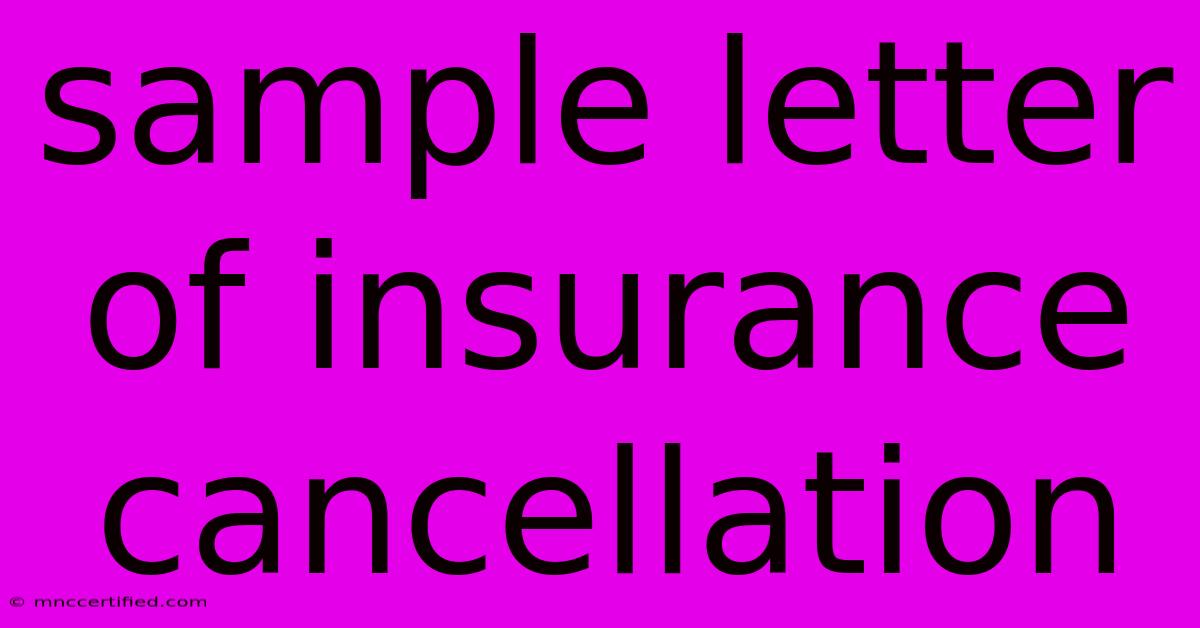Sample Letter Of Insurance Cancellation

Table of Contents
How to Cancel Your Insurance Policy: A Sample Letter and Essential Tips
Tired of your current insurance policy and ready to switch? Whether you're unhappy with your coverage, seeking better rates, or simply need a change, knowing how to properly cancel your insurance is crucial. This guide walks you through the process with a sample letter, key considerations, and helpful tips to ensure a smooth transition.
Understanding Your Policy
Before diving into the cancellation process, it's essential to thoroughly review your policy documents. Pay close attention to the following:
- Cancellation Clause: This section outlines the specific procedures and any potential fees associated with ending your policy.
- Notice Period: The policy will state the minimum amount of time you need to inform your insurer before your policy ends. This period can range from a few days to several weeks, depending on your coverage type.
- Cancellation Fees: While some policies are free to cancel, others might charge fees for early termination.
Sample Letter of Insurance Cancellation
Here is a sample letter you can adapt to your specific situation:
[Your Name] [Your Address] [Your Phone Number] [Your Email Address]
[Date]
[Insurance Company Name] [Insurance Company Address]
Subject: Cancellation of Insurance Policy - [Policy Number]
Dear [Insurance Company Representative],
This letter serves as formal notification that I wish to cancel my insurance policy [policy number], effective [date].
[Optional: Briefly state your reason for cancellation - e.g., "I am switching to a different insurance provider offering more suitable coverage."]
Please confirm the receipt of this notice and provide me with any necessary instructions regarding the cancellation process. I would also appreciate information on any potential cancellation fees associated with this policy.
Thank you for your time and assistance.
Sincerely, [Your Signature] [Your Typed Name]
Key Considerations When Canceling Insurance
- Proof of Delivery: It's highly recommended to send your cancellation letter via certified mail with return receipt requested. This provides you with a record of delivery and ensures the insurer receives your notice.
- Confirm Cancellation: After sending your letter, follow up with the insurer to confirm the cancellation and inquire about any outstanding payments or refunds.
- New Coverage: Before canceling your existing policy, make sure you have secured alternative coverage if needed. This will prevent any gaps in your insurance protection.
- Keep Records: Retain copies of your cancellation letter, confirmation of receipt, and any communication with the insurer for your records.
Off-Page SEO Strategies for Your Blog Post
- Backlinks: Reach out to relevant websites, blogs, or forums related to insurance and request a link to your article.
- Social Media Sharing: Share your post on social media platforms like Facebook, Twitter, and LinkedIn, using relevant hashtags.
- Guest Blogging: Consider writing guest posts on other blogs in your niche, including a link back to your article.
- Forum Participation: Engage in forums and online communities where people discuss insurance topics, providing helpful insights and sharing your article link.
By following these steps and incorporating these off-page SEO strategies, you can effectively promote your blog post and improve its visibility in search results.
Conclusion:
Navigating the insurance cancellation process doesn't have to be a hassle. By understanding your policy terms, following the proper procedures, and using a sample cancellation letter, you can confidently end your insurance policy while ensuring a smooth transition.

Thank you for visiting our website wich cover about Sample Letter Of Insurance Cancellation. We hope the information provided has been useful to you. Feel free to contact us if you have any questions or need further assistance. See you next time and dont miss to bookmark.
Featured Posts
-
Sentinel Insurance Company Phone Number
Nov 08, 2024
-
Spider Vein Removal Covered By Insurance
Nov 08, 2024
-
Is Urgent Care Expensive With Insurance
Nov 08, 2024
-
Thornton Admits Film Was Career Ender
Nov 08, 2024
-
Outer Banks Part 2 What You Need To Remember
Nov 08, 2024